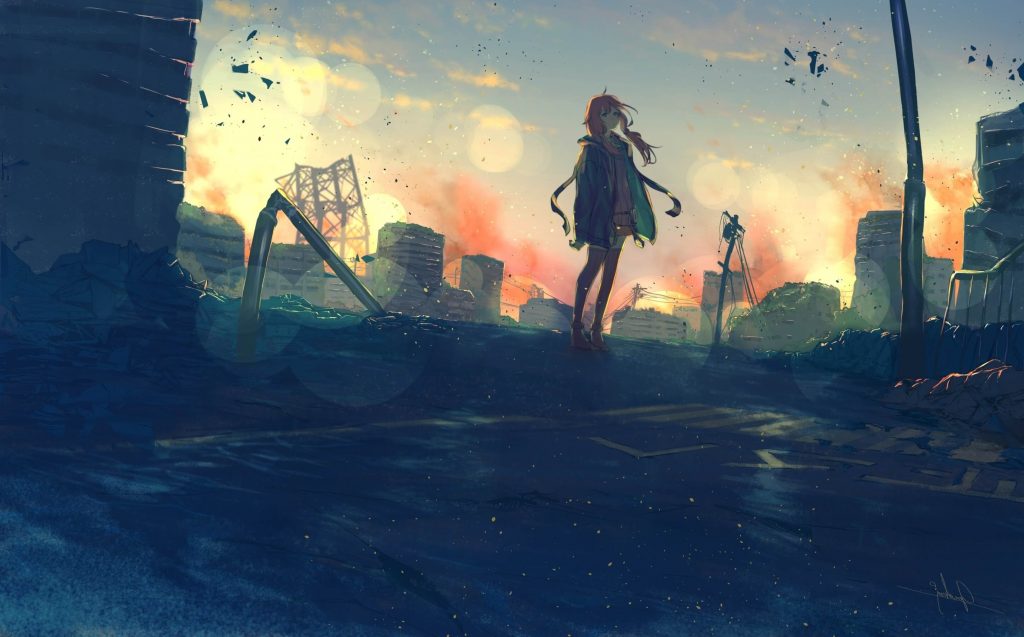What comes to mind when thinking about the apocalypse? Invading aliens or undead zombies? And if each culture and society has its own unique interpretation of the end of the world, what makes Japan’s take so special? Drawing from a range of texts spanning live-action films to anime, this issue studies different manifestations of Japanese apocalypticism. Although many variations appear, we find that an interrogation of identity remains a focal point. These texts encourage both Japanese and international audiences to ask what values are preserved? What is the role of the environment and how can it be saved? What are we without our collective past? We evoke and address these questions through discussing different ideas, concepts and themes such as ikigai, self-sacrifice and bushido to Japan’s historic relationship with nature in popular Japanese media.
Everyone, deep in their hearts, is waiting for the end of the world to come.
Haruki Murakami, 1Q84
In this issue, the authors unpack aspects of the Japanese apocalypse by analysing their culturally-specific traits as depicted in different texts to gain insight into Japanese culture. While each author grapples with different contexts and apocalyptic visions, we collectively seek to answer the question, “What makes apocalypticism in Japan uniquely Japanese?”

What is the apocalypse and how is it presented across time? Firstly, Wong Zhi Wei in Neon Genesis Evangelion (1995): From Armageddon to Instrumentality, Japanese Anxiety Through The Hikikomori analyses the critically-acclaimed anime television series and, in noting the various interpretations of apocalypticism in Japanese fiction across time, posits that the series subverts the classical notion of the biblical apocalypse through its portrayal and critique of the Hikikomori. He argues that the show signals a departure from classical fears associated with nuclear annihilation or climate change, and instead puts forth a new kind of anxiety that captures the zeitgeist of the lost decade of the 90s, wherein young adults struggling to cement themselves as members of society choose to run away and turn to escapist mediums as forms of comfort that shield them from an unpredictable and unstable social and political order.

Values and systems of beliefs are a pivotal aspect of Japanese culture. Values drive the understanding of morality, even in the apocalypse. Therefore, what can we do in the face of the apocalypse? Shermaine Lee discusses how realising one’s Ikigai, the Japanese interpretation of one’s life purpose, powers individuals with resilience through the apocalypse in Down the Rabbit Hole: The Strength of Ikigai in Transforming Characters in Alice in Borderland. Through an analysis of the transformational journeys of two characters, she explores Ikigai as both a social and individual concept, borne through not just self-reflection of one’s passions, but also through pain and hardship, strengthening characters in the face of challenges.

Against the apocalypse, how do our cultural values and priorities change? Is there a shift between how people of different cultures understand the meaning of ‘self’ and what does this mean for the way we value ourselves and people around us? In The Japanese Perspective on Self-Preservation and Self-Sacrifice, Desiree Wee investigates the dichotomy between self-preservation and self-sacrifice in the massively-successful anime television series Sword Art Online (2012) by Reki Kawahara, positing a struggle between two quintessential Japanese virtues of self-preservation and self sacrifice, both of which seeks to achieve the greater good for society and yet are apparently incompatible with each other. In order to resolve this conflict, she will explore the understanding of ‘self’ in the Japanese context and contrast.

Chan Xue Hong however, argues differently. She argues in Vocaloid songs: Being vocal about disapproving collectivistic traditional values that the Japanese doomsday vocaloid songs “Shuumatsu ga Yattekuru!” and “Bokura no 16bit Sensou” by sasake.UK subvert the traditional notion of self-sacrifice in the name of collectivism as being noble and socially-desired. Instead, the songs highlight the over-glorification of social conformity and offer an individualistic approach to social existence, where individual pain and suffering indicates a superficial understanding of ‘dying for one’s country’.
Finally, the last question this article seeks to tackle revolves around the salvation of humanity even after the occurrence of the apocalypse. Can human civilization be saved in spite of a post-apocalyptic world decimated by toxic vapors? Yu Jia Lin and Georgia Yew both refer to the same text, Nausicaa of the Valley of the Wind (1984), to answer this question.

In The East and West in Nausicaä: A Question of Environmental Ethics, Yu Jia Lin analyses the different cultural ideologies of Japan and the West from the perspective of the environment. Through her analysis of Nausicaä and Kushana, the respective protagonist and antagonist of the film Nausicaä of the Valley of the Wind (1984), she posits that both characters are metonymic of the Japanese and Western ideologies towards climate change and the conflicting views each hold towards how nature is perceived. This analysis seemingly portrays the Western ideology as undesirable and the Japanese view of nature to be superior. However, this does not follow through in her article; rather, she does not affirm either ideology to be better than the other and instead questions the cultural position of Japan and its treatment of the environment, ultimately revealing the existing ambiguity and contradictions within Japan’s treatment of the environment in our present day society.

Lastly, Georgia Yew takes a deeper dive into Miyazaki’s work concerning nature and ecology, and explores two seminal works, Nausicaä of the Valley of the Wind (1984) and Princess Mononoke (1997). In Rehabilitation after apocalypses: Miyazaki’s meditations Nausicaä of the Valley of the Wind and Princess Mononoke, she compares the post-apocalyptic setting of Nausicaa against the impending apocalypticism of Princess Mononoke, wherein both portray nature threatening human existence. She posits that while both films regard humanity’s recovery with optimism, they present critically different outlooks on mankind’s recovery after the apocalypse. While Princess Mononoke presents a stable departure from the past with nature’s rebirth, Nausicaä projects a hopeful although uncertain post-apocalyptic vision.
